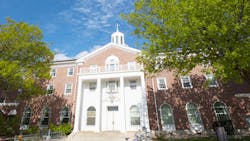Inside: Deferred Maintenance
State bonds enable University of Nebraska system to address deferred maintenance
The University of Nebraska system has spent more than $57 million in the past year to address a huge backlog of deferred maintenance projects on its campuses.
The Lincoln Journal-Star reports that the university has been able to make a dent in its maintenance backlog after state legislation last year secured $400 million in bond financing to address deferred maintenance projects over the next 40 years.
The university system has spent $57.9 million so far on roughly 80 projects at its campuses in Lincoln, Omaha and Kearney, according to data provided by the university.
Among the projects completed: replacing windows, repairing leaks, upgrading heating and cooling systems, removing asbestos, and improving lighting.
More than one-third of the 900 or so buildings in the University of Nebraska system are 50 years or older and need significant upgrades to make them suitable for modern-day education, the university says.
Dozens of the maintenance projects that the university is tackling are not the kinds of work that attract a lot of support from donors, who “are not always excited about "replacing sewer pipes or broken air conditioners," said Chris Kabourek, the university's vice president of business and finance.
"That was the intent: to go in and use this money for a lot of those projects that are important but not noticeable, at least until something breaks," Kabourek says.
NU worked with a consultant to identify and prioritize a list of deferred maintenance projects.
In 2030-31, Nebraska plans to pursue a second round of bond financing that would address the remainder of the university’s maintenance backlog.
Beaverton (Ore.) bond package includes $120 million for deferred maintenance
A bond proposal approved by voters in the Beaverton (Ore.) school district earlier this year will pay for $120 million in deferred maintenance projects.
The maintenance projects covered by bond funds are larger jobs, such as roofs, HVAC upgrades and site improvements. The district’s general fund budget covers regular maintenance costs and inspections, but it is not sufficient to cover larger repairs or equipment replacement.
A consultant’s study in 2019 found that the district’s 10-year deferred maintenance needs totaled $610 million.
In addition to the deferred maintenance, Beaverton’s $723 million bond package will enable the district to replace Beaverton High School and the Raleigh Hills K-8 School. Rebuilding Beaverton High would eliminate about $53 million of deferred maintenance at the school, the district says.
Idaho report says school maintenance backlog runs into the billions
A survey of 77 of the 115 school districts in Idaho found that it would cost an estimated $847 million to bring all the schools in those districts up to "good" condition.
The 2022 report by the Idaho Legislature's Office of Performance Evaluations says that those districts would need to spend $1.3 billion to get their building to "perfect" condition.
The report draws attention to the uphill struggle Idaho schools have to improve the condition of their facilities. It notes that centralized information about the condition of Idaho school buildings is scarce or nonexistent and that Idaho ranks near the bottom nationally for funding school building maintenance, both on a per-student and per-building gross square footage basis.
School districts are required to submit 10-year maintenance plans to the state detailing conditions of their buildings and upcoming maintenance projects, but few do so. "Only 33 of the 115 districts submitted maintenance plans to the state from 2016 to 2020," the report says.
The districts that responded to the survey accounted for 35.6 million gross square feet of school buildings; they rated over 22 million square feet of that space as "fair" or "poor."
Noting that the legislature has not commissioned a statewide facility condition assessment since 1993, the report recommends that the legislature do so.
"A statewide facility condition assessment of schools would inform the Legislature of the true conditions of school buildings statewide and the costs of needed upgrades and repairs," the report says.
